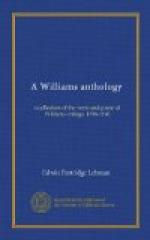The wide old street was as hospitable then as now; if the elms were something less paternal in their benediction their stature was fair and their shade was ample; but the aspect of the street—how greatly changed since then! There were two or three fine old colonial houses, which are standing now and are not likely to be improved upon; but most of the dwellings were of the orthodox New England village pattern, built, I suppose, to square with the theology of the Shorter Catechism, or perhaps with the measurements of the New Jerusalem, the length and breadth and height of which are equal. The front yards were all enclosed with fences, none of which were useful and few of which were ornamental. The broad-shouldered old white Congregational meeting-house stood at the top of the street in Field Park; it was the goal of restless Sophomores for several hours every Sunday, and it was also the goal of all ambitious contestants for college honors. Griffin Hall was then chapel, museum, laboratories, and recitation-rooms; East, South, and West Colleges, with Kellogg Hall, on the West lawn,—“factories of the muses,” in Lowell’s expressive phrase,—stood forth in their naked practicality much as they stand to-day. Lawrence Hall library, in its earlier, wingless character of colossal ink-pot, Jackson Hall[2] and the little magnetic observatory, still standing, completed the catalogue of the college buildings.
The faculty of that day can be recalled without difficulty: President Hopkins, whose clear and venerable name no eulogy of mine shall here disfigure; his stern-faced but great-hearted brother Albert; Emmons the geologist; Griffin, Tatlock, Lincoln, and Chadbourne, who succeeded Hopkins in the presidency; Bascom, the only survivor to-day, and Perry, the best-known of them all. I have taken no pains to refresh my memory of the faculty of 1856, but I am confident that here are no omissions. It will be somewhat less easy for undergraduates to-day, writing so many eventful years after their entrance, to recall the names of their teachers. One only of our memorable nine is now in service, and long may he serve the community! All these were ranked as professors; there had been tutors and instructors before our days, but none in our time.
The Gul of those days was a four-page sheet containing in briefest form the membership and official lists of the various fraternities and associations; it sold for ten cents a copy. The only other college publication was the Quarterly, a solid magazine of about one hundred pages. None of the fraternities then existing, I think, possessed a chapter-house; their rooms were in more or less obscure quarters, over stores or in private houses. There was quite as much rivalry between them then as now, and poorer spirit. There was also an Anti-Secret Confederation, of which General Garfield in his time was the leader; it mixed freely in college politics and was no less clannish than the other fraternities. The absence




